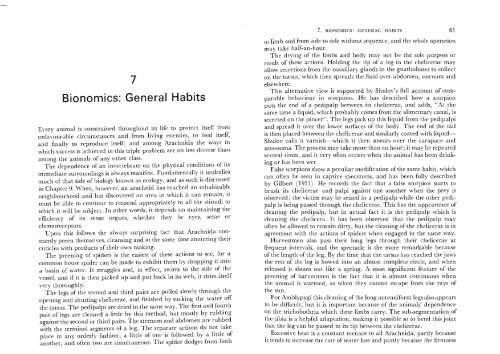You also want an ePaper? Increase the reach of your titles
YUMPU automatically turns print PDFs into web optimized ePapers that Google loves.
7<br />
Bionomics: General Habits<br />
Every animal is constrained throughout its life to protect itself from<br />
unfavourable circumstances and from living enemies, to feed itself,<br />
and finally to reproduce itself; and among <strong>Arachnida</strong> the ways in<br />
which success is achieved in this triple problem are no less diverse than<br />
among the animals of any other class.<br />
The dependence of an invertebrate on the physical conditions of its<br />
immediate surroundings is always manifest. Fundamentally it underlies<br />
much of that side of biology known as ecology, and as such is discussed<br />
in Chapter 9. \\Then, however, an arachnid has reached an inhabitable<br />
neighbourhood and has discovered an area in which it can remain, it<br />
must be able to continue to respond appropriately to all the stimuli to<br />
which it will be subject. In other words, it depends on maintaining the<br />
efficiency of its sense organs, whether they be eyes, setae or<br />
chemoreceptors.<br />
Vpon this follows the always surprising fact that <strong>Arachnida</strong> constantly<br />
preen themselves, cleansing and at the same time anointing their<br />
cuticles with products of their own making.<br />
The preening of spiders is the easiest of these actions to see, for a<br />
common house spider can be made to exhibit them by dropping it into<br />
a basin of water. It struggles and, in effect, swims to the side of the<br />
vessel, and if it is then picked up and put back in its web, it dries itself<br />
very thoroughly.<br />
The legs of the second and third pairs are pulled slowly through the<br />
opening and shutting chelicerae, and finished by sucking the water off<br />
the tarsus. The pedipalpi are dried in the same way. The first and fourth<br />
pair of legs are cleaned a little by this method, but mostly by rubbing<br />
against the second or third pairs. The sternum and abdomen are rubbed<br />
with the terminal segments of a leg. The separate actions do not take<br />
place in any orderly fashion; a little of one is followed by a little of<br />
another, and often two are simultaneous. The spider dodges from limb<br />
7. BIONOMICS: GENERAL HABITS 61<br />
to limb and from side to side without sequence, and the whole operation<br />
may take half-an-hour.<br />
The drying of the limbs and body may not be the sole purpose or<br />
result of these actions. Holding the tip of a leg in the chelicerae may<br />
allow secretions from the maxillary glands in the gnathobases to collect<br />
on the tarsus, which then spreads the fluid over abdomen, sternum and<br />
elsewhere.<br />
This alternative view is supported by Shulov's full account of cornparable<br />
behaviour in scorpions. He has described how a scorpion<br />
puts the end of a pedipalp between its chelicerae, and adds, "At the<br />
same time a liquid, which probably comes from the alimentary canal, is<br />
secreted on the pincer". The legs pick up this liquid from the pedipalpi<br />
and spread it over the lower surfaces of the body. The end of the tail<br />
is then placed between the chelicerae and similarly coated with liquid<br />
Shulov calls it varnish-which it then smears over the carapace and<br />
rnesosoma. The process may take more than an hour; it may be repeated<br />
several times, and it very often occurs when the animal has been drinking<br />
or has been wet.<br />
False scorpions show a peculiar modification of the same habit, which<br />
can often be seen in specimens, and has been fully described<br />
by Gilbert ( 1951). He records the fact that a false scorpion starts to<br />
brush its chelicerae and palpi against one another when the prey is<br />
observed: the victim may be seized in a pedipalp while the other pedipalp<br />
is being passed through the chelicerae. This has the appearance of<br />
cleaning the pedipalp, but in actual fact it is the pedipalp which is<br />
cleaning the chelicera. It has been observed that the pedipalp may<br />
often be allowed to remain dirty, but the cleaning of the chelicerae is<br />
agreement with the actions of spiders when engaged in the same way.<br />
Harvestrnen also pass their long legs through their chelicerae at<br />
frequent intervals, and the spectacle is the more remarkable because<br />
of the length of the leg. By the time that the tarsus has reached the jaws<br />
the rest of the leg is bowed into an almost complete circle, and when<br />
released it shoots out like a spring. A most significant feature of the<br />
preening of harvestmen is the fact that it is almost continuous when<br />
the animal is warmed, as when they cannot escape from the rays of<br />
the sun.<br />
For Amblypygi this cleaning of the long antenniform legs also appears<br />
to be difficult, but it is important because of the animals' dependence<br />
on the trichobothria which these limbs carry. The sub-segmentation of<br />
the tibia is a helpful adaptation, making it possible so to bend this joint<br />
that the leg can be passed to its tip between the chelicerae.<br />
. Excessive heat is a constant menace to all <strong>Arachnida</strong>, partly because<br />
It tends to increase the rate of water loss and partly because the firmness















